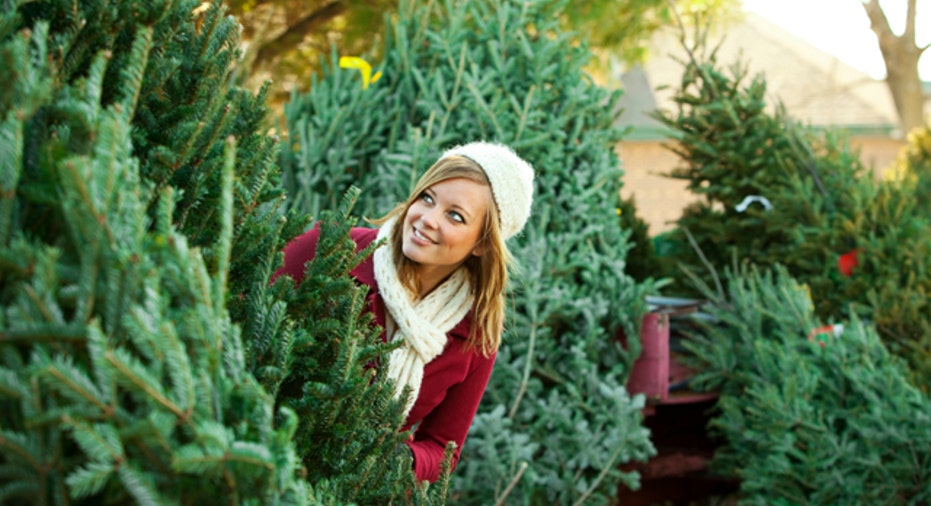The Great Tree Debate: Real vs. Fake

It’s the time of year when many families are heading out to the farm—or up to the attic—to get their Christmas trees. While some can’t imagine the holidays without a tree’s fresh pine smell, others vote for the convenience of an artificial tree packed snugly away.
Although there’s no right answer, there are definite differences in cost and environmental impact that families may want to think about before choosing their evergreen.
Approximately 350,000 acres of Christmas trees gets planted annually in the U.S., says Rick Dungey, public relations manager for the National Christmas Tree Association, and those are trees that would not be planted without the annual demand for live trees.
“These are trees that would not exist without tree farmers. Do away with Christmas tree farms, you’re basically wiping out 350 million trees,” he says.
Dungey says the average cost of a Christmas tree varies widely because the species, size, and location of trees differ nationwide. However, he says that most families should be able to find a nice real tree for under $50, no matter where they live. Artificial trees can range in cost from $100 to more than $1,000 depending on size.
One of the largest sellers of Christmas trees nationwide, Stew Leonard’s Farm Fresh Grocer, sells more than 50,000 trees each year, both real and artificial. Most of the live trees on its lot cost between $30 and $60, with the most expensive coming in at 10-feet-tall with a price of $119. Stew Leonard’s also offers an artificial 10-feet-tall Frasier Fir for $1,000.
Many artificial trees come pre-lit, eliminating the tasks of buying and stringing lights, says Stew Leonard Junior, owner of Stew Leonard’s Farm Fresh Grocer. For consumers buying a real tree, Leonard says to estimate approximately $5 per foot for lights.
When it comes to the cost of a real tree verses the cost of an artificial tree, it all depends on how long you keep your artificial tree, says Dungey.
“To get a really decent artificial tree, you’ll need to spend around $400. If my real tree costs $30 every year, it’s going to be a number of years before I spend what a person would spend on a nice fake one,” says Dungey.
“Do people keep their artificial tree for 10 years? I don’t know,” says Leonard. “If you kept your tree for that long, the price would be worth it.”
But part of the cost of a live tree is entertainment, Dungey says. For many families, buying a tree is an annual event.
“It’s like going to an orchard to pick apples. I can get apples anywhere, but going to the orchard turns it into a fun activity. You’re also paying for that memorable experience,” he says.
When it comes to environmental impact of real trees versus artificial trees, it’s a tough call.
“It’s very similar to the argument of plastic versus paper bags. You really can’t make a strong argument for either one of them, because there are so many pros and cons. But with Christmas trees, I will say that we plant two trees for every one we cut down. It’s not like you’re going out and strip mining,” he says.
Dungey says that for the Christmas Tree Association, the choice is clear.
“Even if you use your tree for 20 years, what’s going to happen to it after that?,” he said. He continued to explain that most artificial trees are non biodegradable and use PVC plastic that can damage the environment.
“A real tree is a plant, all plants die, decompose, and turn back into soil and go back into the earth.”
But according to the American Christmas Tree Association (ACTA), families who have purchased more than nine cut trees over the last nine years should consider investing in an artificial tree. A study conducted by the ACTA showed that one artificial tree used for more than eight Christmas seasons is “environmentally friendlier than purchasing eight or more live cut trees over eight years.”
The ACTA also advises families who own artificial trees to use the tree for at least six to nine years. When an artificial tree needs replacing, families can further reduce their environmental impact by donating it rather than throwing it away.
Botanist Clint Springer, an assistant professor of biology at Saint Joseph's University in Philadelphia, says that even though a real tree is a more organic choice, many people still see cutting down a live tree as a bad thing.
“If you want to look at what is going to help climate change and reduce carbon, Christmas tree farms do an excellent job of sequestering carbon more than other crops because the trees lock away carbon,” says Springer. “Of course there are resources used in the production of the live tree—someone has to grow it, drive to go cut it and transport it via truck to be sold.”
For families who prefer artificial trees, Springer says the most environmentally-friendly thing to do is keep it for as long as you possibly can.
“If you can keep it for 10 years, that’s much better than two or three,” Springer says.“If you buy an artificial tree with LED lights, you’re going to be saving on electricity.”
Erik Friedli, manager at Flamingo Road Nursery and Farmers Market in Davie, Fla., says that once the holidays are over, getting rid of a live tree can be a hassle for families. Many consumers feel that boxing up a reusable evergreen is much easier than searching for a way to dispose a dead tree in January.
“Many people don’t know that a lot of municipalities add Christmas trees to their composting programs and make them into mulch,” says Friedli.
According to the National Christmas Tree Association, there are more than 4,000 local Christmas Tree recycling programs throughout the country.



















